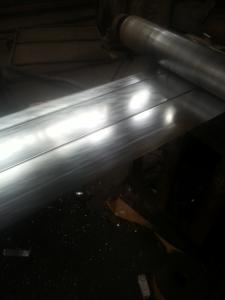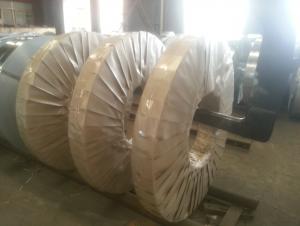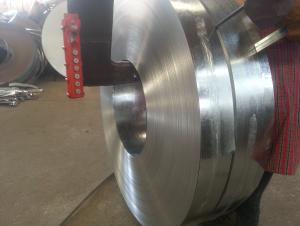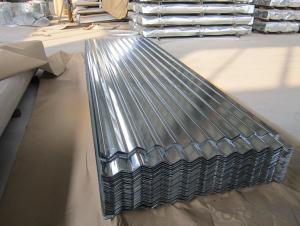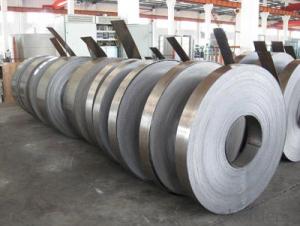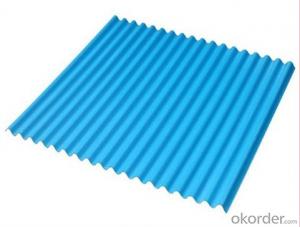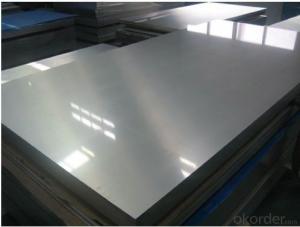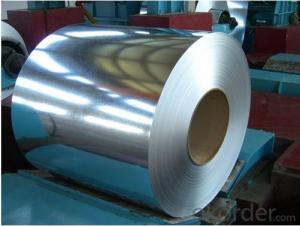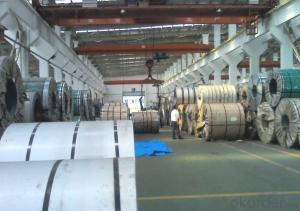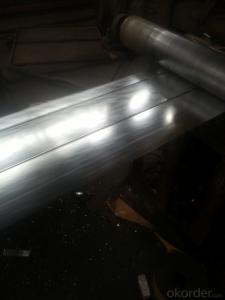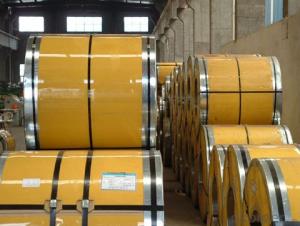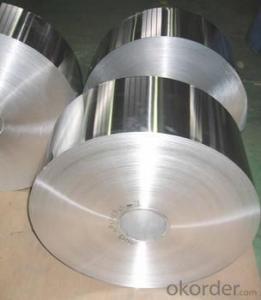Hot Dip Galvanized Steel Strips
- Loading Port:
- China Main Port
- Payment Terms:
- TT OR LC
- Min Order Qty:
- -
- Supply Capability:
- -
OKorder Service Pledge
OKorder Financial Service
You Might Also Like
Product Description:
Hot Dipped Galvanized Steel Strips
Hot-dip galvanized steel strips are available with a pure zinc coating through the hot-dip galvanizing process. It offers the economy, strength and formability of steel combined with the corrosion resistance of zinc. The hot-dip process is the process by which steel gets coated in layers of zinc to protect against rust. It is especially useful for countless outdoor and industrial applications.
Product Description Of Hot Dipped Galvanized Steel Strips
Thickness | 0.18mm-3mm |
Width | less than 600mm |
Zinc Coating | 30-200g/m2 |
Internal Diameter | 508mm/610mm |
Coil Weight | less than 3MT |
Quality | commercial and structural quality |
Surface Treatment | regular & minimum spangle, zero spangle, oiled & dry, chromated , non-skin pass , skin pass |
Standard | JIS G 3302, ASTM A 653M, EN 10327 |
Steel Grade | SGCC, CS, FS, SS, LFQ, DX51D+Z , S280GD |
Technical Data Of Hot Dipped Galvanized Steel Strips
Chemical Composition | C | Si | Mn | P | S |
0.04-0.06% | 0.01-0.03% | 0.18-0.22% | 0.014-0.016% | 0.006%-0.009% |
Yield Strength | (Mpa) 280-320 |
Tensile Strength | (Mpa) 340-390 |
Elongation | 20%-30% |
Out-of-square | not exceed 1% Flatness |
Bow | 15mmmax |
Edge Wave | 9mmmax |
Centre Buckle | 8mmmax |
Bending At 180 Degree | No crack, purling and fraction |
Application Of Hot Dipped Galvanized Steel Strips
It can be widely used in transportation, light industry, civil usage and farming. It is also the perfect building material in construction for making roofing tile, steel profiles for wall partition, T-bar, studs, fireproof door, air conditioning duct and home appliance.
- Q:How are steel strips priced and sold?
- Steel strips are typically priced and sold based on several factors. Firstly, the cost of the raw materials used to produce the steel strips, such as iron ore and other alloys, plays a significant role in determining the price. Fluctuations in the prices of these materials can directly impact the pricing of steel strips. Additionally, the manufacturing process and overhead costs involved in producing steel strips influence their pricing. This includes expenses related to labor, energy, equipment, and transportation. Quality standards and certifications, such as ISO certifications, can also affect the price as they ensure the product meets certain criteria. Market demand and competition also play a role in pricing steel strips. Higher demand for steel strips can lead to increased prices, especially when supply is limited. Conversely, if there is low demand or excess supply, prices may be more competitive. Steel strips are typically sold through various channels, including steel service centers, distributors, and directly from manufacturers. Steel service centers and distributors act as intermediaries, purchasing steel strips in bulk from manufacturers and reselling them to end-users. They often offer additional services such as cutting, slitting, or customizing the steel strips based on customer requirements. Direct sales from manufacturers are also common, particularly for larger orders or when customers have specific preferences or requirements. Manufacturers may have their own sales teams or work with agents or representatives to facilitate the sale of steel strips. In summary, steel strip pricing is determined by factors such as raw material costs, manufacturing expenses, quality standards, market demand, and competition. The sales of steel strips can be carried out through steel service centers, distributors, or directly from manufacturers.
- Q:What are the different methods for leveling steel strips?
- There are several different methods for leveling steel strips, depending on the specific requirements and desired outcome. 1. Roller Leveling: This method involves passing the steel strip through a series of rollers that apply pressure to bend and flatten the material. The rollers can be adjusted to achieve the desired levelness, and this method is commonly used for thin and wide steel strips. 2. Stretch Leveling: This technique involves stretching the steel strip beyond its yield point to remove any internal stresses and improve flatness. The strip is fed through a set of powered rollers that stretch it in both directions, effectively straightening and leveling the material. 3. Tension Leveling: Similar to stretch leveling, tension leveling uses a series of rollers to stretch the steel strip. However, in tension leveling, the strip is pulled to a specific tension, rather than beyond its yield point. This method is often used for thicker steel strips and provides excellent flatness control. 4. Temper Rolling: This method involves subjecting the steel strip to a controlled amount of cold rolling after annealing or heat treatment. By reducing the thickness and elongating the strip, temper rolling helps to improve the flatness and overall quality of the material. 5. Precision Leveling: Precision leveling is a more advanced method that utilizes hydraulic or mechanical presses to apply pressure on specific areas of the steel strip. This technique is particularly effective for correcting localized defects or unevenness in the material. 6. Laser Leveling: Laser leveling uses a laser beam to measure the surface profile of the steel strip and then applies heat or mechanical force to remove any irregularities. This method offers high precision and is commonly used for leveling thin and sensitive steel strips. Each of these methods has its own advantages and limitations, and the choice of leveling technique depends on factors such as strip thickness, material properties, desired flatness, and production requirements.
- Q:How do steel strips contribute to the strength of structures?
- There are several ways in which steel strips enhance the strength of structures. To begin with, steel is a remarkably strong and robust material, renowned for its high tensile strength. When steel strips are incorporated into a structure, they offer reinforcement and support, assisting in bearing heavy loads and resisting external forces like wind or earthquakes. This reinforcement prevents the structure from deforming or collapsing, ensuring its stability and longevity. Furthermore, steel strips can be strategically positioned in crucial areas of a structure to distribute and transfer loads more efficiently. By functioning as load-bearing components, they can effectively shift the weight and stress from one area to another, preventing localized weak points or failures. This load distribution helps evenly spread the forces acting on the structure, enhancing its overall strength and stability. Additionally, steel strips often serve as tension members in structures, such as beams or columns. Due to their high tensile strength, they can withstand pulling forces and prevent the structure from being torn apart. This is particularly vital in structures that might experience significant tension forces, such as bridges or tall buildings, where the steel strips counteract gravity's effects and maintain the structure's integrity. Moreover, steel strips are resistant to corrosion and degradation, making them highly suitable for long-term structural applications. This durability ensures that structures maintain their strength and integrity over time, reducing the need for frequent repairs or replacements. By incorporating steel strips into the construction process, the structure remains sturdy and resilient for many years. In conclusion, steel strips make a significant contribution to the strength of structures by providing reinforcement, load distribution, tension resistance, and durability. Their integration guarantees the stability, safety, and longevity of various types of structures, ranging from buildings and bridges to infrastructure and industrial facilities.
- Q:What are the different edge finishes available for steel strips?
- Some of the different edge finishes available for steel strips include deburred edges, rounded edges, square edges, slit edges, and sheared edges.
- Q:How do steel strips perform in electrical conductivity applications?
- Steel strips have relatively poor electrical conductivity compared to other metals such as copper or aluminum. While they can conduct electricity to some extent, their conductivity is significantly lower. Therefore, steel strips may not be the most ideal choice for applications where high electrical conductivity is required.
- Q:How are steel strips used in the production of metal signage?
- Steel strips are an essential component in the production of metal signage. They play a crucial role in providing the structural support and durability required for these signs. Steel strips are typically used as the base material for metal signage. They are cut to the desired size and shape, forming the foundation upon which the sign is built. The strips are chosen for their strength and ability to withstand various environmental conditions, ensuring the longevity of the signage. In the manufacturing process, steel strips are often coated with a protective layer to prevent rusting and corrosion, further enhancing their durability. This coating can be in the form of paint, powder coating, or galvanization, depending on the specific requirements of the signage. Additionally, steel strips are used to create raised or embossed lettering on the signage. These strips are precisely shaped and molded to form the desired text or design. This technique adds a visually appealing and three-dimensional element to the sign, making it more eye-catching and professional. Moreover, steel strips are used for mounting the metal signage. They can be welded or attached with screws to walls, posts, or other structures, securely holding the sign in place. This ensures that the signage remains stable and visible, even in harsh weather conditions. Overall, steel strips are an integral part of the production process for metal signage. They provide the necessary strength, durability, and versatility required for creating visually appealing and long-lasting signs.
- Q:How are steel strips used in the production of automotive components?
- Steel strips are used in the production of automotive components as they are strong and durable. These strips are often shaped and formed to create various parts such as body panels, chassis components, and reinforcements. They provide structural integrity and help enhance the overall safety and performance of the vehicles.
- Q:Are steel strips suitable for the manufacturing of pressure vessels?
- Yes, steel strips are suitable for the manufacturing of pressure vessels. Steel strips provide high strength, durability, and resistance to pressure, making them a reliable choice for constructing pressure vessels. Additionally, steel strips can be easily formed and welded into various shapes and sizes, allowing for flexibility in designing and manufacturing pressure vessels to meet specific requirements.
- Q:Can steel strips be used in the production of firearms?
- Yes, steel strips can be used in the production of firearms. Steel strips are often used as raw materials for manufacturing various components of firearms, such as barrels, frames, and receivers. The high strength, durability, and versatility of steel make it an ideal material for firearm production.
- Q:What are the different surface coating methods for steel strips?
- Some of the different surface coating methods for steel strips include hot-dip galvanizing, electro-galvanizing, metallic coatings, organic coatings, and powder coating.
1. Manufacturer Overview |
|
|---|---|
| Location | |
| Year Established | |
| Annual Output Value | |
| Main Markets | |
| Company Certifications | |
2. Manufacturer Certificates |
|
|---|---|
| a) Certification Name | |
| Range | |
| Reference | |
| Validity Period | |
3. Manufacturer Capability |
|
|---|---|
| a)Trade Capacity | |
| Nearest Port | |
| Export Percentage | |
| No.of Employees in Trade Department | |
| Language Spoken: | |
| b)Factory Information | |
| Factory Size: | |
| No. of Production Lines | |
| Contract Manufacturing | |
| Product Price Range | |
Send your message to us
Hot Dip Galvanized Steel Strips
- Loading Port:
- China Main Port
- Payment Terms:
- TT OR LC
- Min Order Qty:
- -
- Supply Capability:
- -
OKorder Service Pledge
OKorder Financial Service
Similar products
New products
Hot products
Hot Searches
Related keywords

